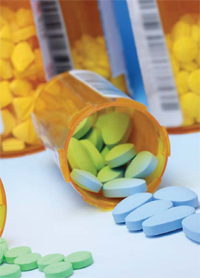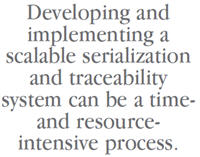Serialization And Regulatory Compliance: Start Small To End Big
By Matt Walker, EVP for supply chain, TAKE Solutions’
 Many pharmaceutical and life sciences companies are feeling the pressure of pending state and federal regulations that take a more stringent stance on drug safety and supply chain integrity. Spurred on by consumer advocacy and a rise in drug diversion, theft, counterfeiting, and shortages, forwardthinking pharmaceutical and biomedical manufacturers are proactively assessing their readiness to adhere to new and ever-changing regulatory requirements. For most, waiting is not an option. Without firm standards currently in place, a cautious approach is sensible, but misjudging the pace of regulatory changes or the determination of competitors can put pharmaceutical, biotech, and medical device companies behind the curve, scrambling to catch up to a changing market environment.
Many pharmaceutical and life sciences companies are feeling the pressure of pending state and federal regulations that take a more stringent stance on drug safety and supply chain integrity. Spurred on by consumer advocacy and a rise in drug diversion, theft, counterfeiting, and shortages, forwardthinking pharmaceutical and biomedical manufacturers are proactively assessing their readiness to adhere to new and ever-changing regulatory requirements. For most, waiting is not an option. Without firm standards currently in place, a cautious approach is sensible, but misjudging the pace of regulatory changes or the determination of competitors can put pharmaceutical, biotech, and medical device companies behind the curve, scrambling to catch up to a changing market environment.
 There is no doubt that for most organizations — even those that control a majority of the manufacturing in-house — upgrading to item-level serialization and e-pedigree tracking capabilities to match anticipated regulatory changes and market shifts can be a highly daunting proposition. In analyzing the various challenges of serialization, pharmaceutical and life sciences companies must first evaluate the processes, partners, and technologies within and outside the organization.
There is no doubt that for most organizations — even those that control a majority of the manufacturing in-house — upgrading to item-level serialization and e-pedigree tracking capabilities to match anticipated regulatory changes and market shifts can be a highly daunting proposition. In analyzing the various challenges of serialization, pharmaceutical and life sciences companies must first evaluate the processes, partners, and technologies within and outside the organization.
Harnessing the enormous complexity of increasingly global and diverse pharmaceutical supply chains is a formidable task. As a result, many organizations embark on an iterative process, starting small to end big. For most organizations, it starts with an evaluation of internal manufacturing, packaging, and shipping processes. A medium-tier biopharma firm, for example, recently completed a pilot project related to item-level serialization that involved the integration of an electronic product code information services (EPCIS)-compliant event repository (ER). The ER receives data from shop floor tracking and serialization software, which is also fed to the ERP (enterprise resource planning) system. Both systems receive the data they need for reporting, analytics, and decision making. The next step for this company will be to expand its evaluation to supply-side trading partners, transportation, and buy-side trading partners to develop a closed-loop serialization and traceability solution.
Assessing The Current State of Readiness
The first and crucial step is an assessment of processes and systems, where organizations look internally, to assess risks, gaps, and opportunities. Organizations must ask a series of questions. It’s best to begin with key top-level areas of focus. Who owns the issue? Who else is impacted? (Many times the impact can go all the way to pharmacovigilance and regulatory affairs.) What level of visibility and decision making is required? Will there be a need to support regulations from other countries or regions of the world? Is there executive sponsorship? Is this viewed as a cost center, or is it viewed as a way to reduce leakage from chargebacks? More tactical questions are also required. What are the capabilities of current systems? What will it take to convert to item-level serialization? Is there technology in place to allow the necessary level of data communication with all trading partners downstream, even when the pallet and case parent/ child relationship is disrupted? Solutions must go beyond packaging to encompass process alignment with manufacturing, trading, and distribution partners for coordinated quality and compliance, and smart technology (that collects and analyzes data in near real time) integration.
Engaging early and often in conversation with supply chain partners, like contract manufacturers, third-party logistics (3PL) providers, and distributors can be a good proactive next step, especially as regulatory issues become more certain. Understanding the serialization capabilities of partner organizations (i.e. the capability to serialize and trace at the item level) and filling in any gaps by freeing up the flow of data across the supply network are critical requirements. Aligning internal resources to share best practices and data across the extended supply chain is crucial in ultimately ensuring closed-loop serialization and traceability compliance. Another forward-thinking biopharma company is leveraging collaboration technology to create small-batch serialization and traceability on their APIs. In the event of a quality issue or recall, the raw materials data is readily available and allows for faster and more accurate pinpointing at the batch level, reducing cost, time, and potential brand risk.
Ensuring Data Transparency and Smart Decision Making
As with many business problems today, technology can be a key facilitator to aligning people and processes. Nextgeneration serialization and traceability solutions are evolving into a network of integrated systems that include a number of components, including item-level serialization and traceability at multiple levels (i.e. before, during, and postpackaging line), regulatory monitoring, EPCIS-compliant event repositories, and B2B/EDI (electronic data interchange) communications that allow data flow across all parties. Some organizations have components of these systems already in place, but need to work on assessing their role in an integrated, technologydriven solution. Serialization and traceability as well as business communication and collaboration technology is required. The good news is that as technology continues to mature and become more heterogeneous, the requirement to rip and replace current systems is rapidly fading. In many cases, a good part of a company’s existing technology can be leveraged in one way or another as a part of a forward-thinking serialization and traceability solution. Supply chain executives must work with IT to assess the value of existing systems and applications and assess technology gaps. This also adds value to solution partner selection and pilot program development.
The “LEGO” Approach
Not surprisingly, biopharma as a whole lags behind other industries, such as aerospace, defense, and high tech, in supporting item-level serialization and traceability across the value chain. There are a number of causal factors; however, part could be attributed to the historical regulatory ceiling, and part could be attributed to the increased role wholesalers and distributors have taken on in the area of information services. However, as manufacturers become more responsible for item-level e-pedigree, this will most likely change.
 Today, more companies are taking the first steps toward proactively assessing existing systems and processes and determining the serialization and traceability requirements of the upcoming changes in California law. The goal is to create a seamless system of technology and processes that not only collect information on items, cases, and pallets at various stages of movement through the value chain, but also free up the movement of that collected data in a way that it is available in real time to key stakeholders for faster decision making.
Today, more companies are taking the first steps toward proactively assessing existing systems and processes and determining the serialization and traceability requirements of the upcoming changes in California law. The goal is to create a seamless system of technology and processes that not only collect information on items, cases, and pallets at various stages of movement through the value chain, but also free up the movement of that collected data in a way that it is available in real time to key stakeholders for faster decision making.
Developing and implementing a scalable serialization and traceability system can be a time- and resource-intensive process. That is unless a “LEGO” approach is employed and organizations create and stack the technology, resources, and process-building blocks toward true item-level serialization and traceability capabilities. From accessing the current state and ensuring item-level data collection to creating a layer of data flow across disparate internal and external systems, the smart approach, in an increasingly more restrictive regulatory environment, is to seize the opportunity today and start down the road toward broad implementation.
